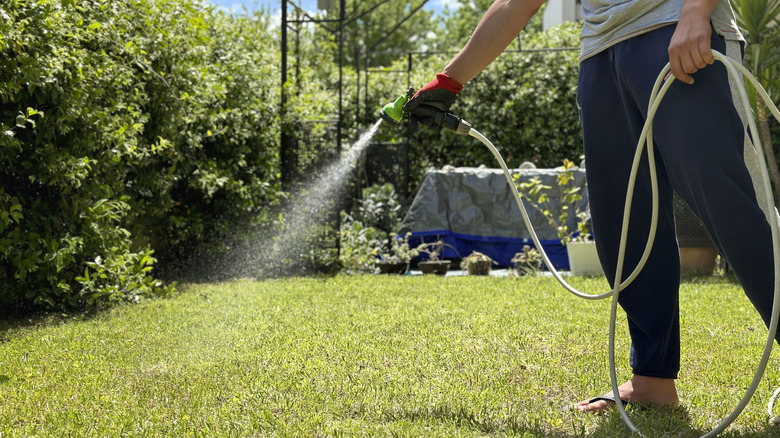The Best Way To Get Rid Of Pesky Crabgrass Before It Takes Over Your Yard
We may receive a commission on purchases made from links.
Crabgrass (Digitaria sanguinalis) is a common lawn weed that loves to invade yards across North America. While it can pop up in nearly any turf, it has a particular affinity for lawns. As a fast-spreading summer annual, crabgrass sprawls across the ground, making it tough to control. Each plant can produce thousands of seeds throughout the summer, which settle into the soil and sprout the following year or several years later. So, getting rid of it means tackling not just the visible plant but also the hundreds of potential seeds lying in wait beneath the surface.
While crabgrass spreads quickly, the good news is that it's not too tough to control. If you're noticing just a couple of small crabgrass plants in your yard, your first line of defense is weeding by hand. This works because crabgrass has shallow roots. To make the job easier, water the area to soften the soil, then use an upright weeding tool, like a weed puller. If the crabgrass has already spread to multiple plants but is still minor, you could spray post-emergent crabgrass herbicide to kill them, but keep in mind that this could potentially harm other nearby plants, including edible ones.
In both cases, you'll need to treat the soil next year to prevent the seeds from turning into new plants. Sometimes, if the infestation has gotten out of hand, it's best to wait it out and let the plants die in the fall, then prevent the seeds from sprouting the following year with a pre-emergent herbicide instead.
Preventing crabgrass seeds from sprouting
Timing is everything when applying herbicides. The ideal window for pre-emergence herbicides is when soil temperatures consistently reach around 55 degrees Fahrenheit for four to five consecutive days. This typically occurs in the spring, typically between mid-April and mid-May, though it can vary by region and year. Once temperatures reach around 65 degrees Fahrenheit, crabgrass can spread rapidly. Consider monitoring the National Weather Service's soil temperature maps or investing in a cheap soil thermometer to help you nail the right time window.
Appropriate lawn care and mowing techniques can help you prevent crabgrass from returning to your yard in the future. Crabgrass thrives in stressed lawns, especially along the edges where soil meets pavement or in bare, neglected spots. The best defense against crabgrass is maintaining a thick, healthy lawn. A well-maintained lawn leaves little room for this pesky invader to take hold! You should avoid mowing your lawn too short and too often. In general, high-cut grass tolerates more stress and reduces the germination of crabgrass seeds, which is a great natural way to reduce how much herbicide you use.
To fix a lawn that's been overrun by crabgrass, you have two options. Either seed the grass at the end of summer or the beginning of fall, when you regularly would. Otherwise, try seeding those bare spots left behind by the weed as early as you can in the spring, before you apply pre-emergent crabgrass herbicide.

